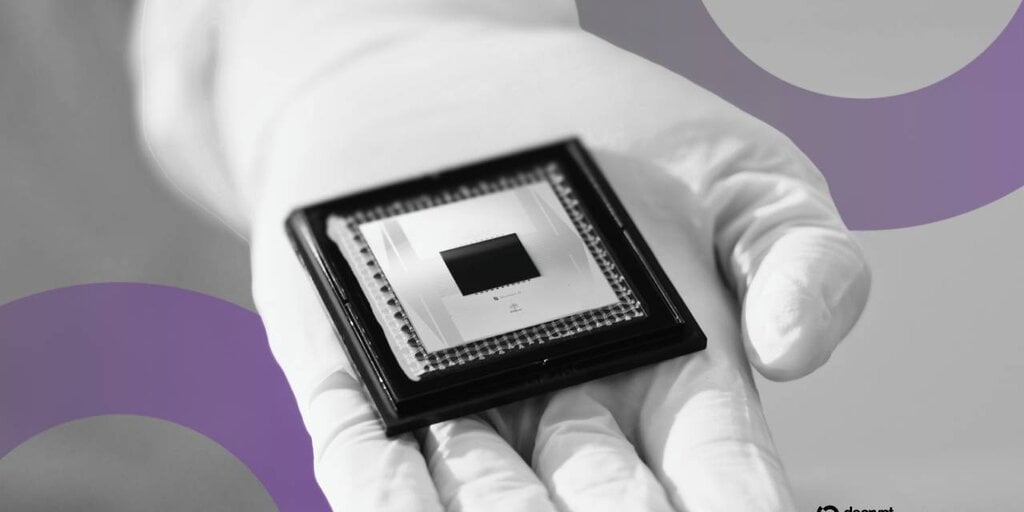In brief
- IBM researchers entangled 120 qubits, setting a new benchmark for quantum computing.
- The GHZ “cat state” achieved fidelity of 0.56, proving full multi-qubit entanglement.
- Direct Fidelity Estimation confirmed results, offering scalable quantum verification.
IBM’s latest quantum breakthrough has edged the crypto world a little closer to its nightmare scenario—a computer capable of breaking Bitcoin’s encryption.
In a report published earlier this month, researchers at IBM reported creating a 120-qubit entangled quantum state —the most significant and most stable of its kind to date.
The experiment, described in a paper titled “Big Cats: Entanglement in 120 Qubits and Beyond,” demonstrates genuine multipartite entanglement across all qubits—a key step toward fault-tolerant quantum computers that could one day run algorithms powerful enough to crack modern cryptography.
“We seek to create a large entangled resource state on a quantum computer using a circuit whose noise is suppressed,” the researchers wrote. “We use techniques from graph theory, stabilizer groups, and circuit uncomputation to achieve this goal.”
The report arrives amid rapid advances and growing competition among major tech firms to develop practical quantum computers. IBM’s breakthrough surpasses Google Quantum AI, whose 105-qubit Willow chip last week ran a physics algorithm faster than any classical computer could simulate.
Building a bigger cat
In the study, the IBM team used a class of quantum states known as Greenberger–Horne–Zeilinger, often called “cat states” after Schrödinger’s famous thought experiment.
A GHZ state is a system in which every qubit exists in a superposition of all being zero and all being one at once. If one qubit changes, they all do—something impossible in classical physics.
“Besides their practical utility, GHZ states have historically been used as a benchmark in various quantum platforms such as ions, superconductors, neutral atoms, and photons,” they wrote. “This arises from the fact that these states are extremely sensitive to imperfections in the experiment—indeed, they can be used to achieve quantum sensing at the Heisenberg limit,” they said, referencing the ultimate limit on how precisely something can be measured in quantum physics.
To reach 120 qubits, IBM researchers used superconducting circuits and an adaptive compiler that mapped operations to the least noisy regions of the chip.
They also employed a process called temporary uncomputation, momentarily disentangling qubits that had finished their role, allowing them to rest in a stable state before being reconnected later.
How “Quantum” is it really?
The quality of the result was measured using fidelity, a gauge of how closely the produced state approximates the ideal mathematical state.
A fidelity of 1.0 would mean perfect control; 0.5 is the threshold that confirms full quantum entanglement. IBM’s 120-qubit GHZ state scored 0.56, enough to prove that every qubit remained part of a single, coherent system.
Directly verifying such results is computationally impossible—testing all configurations of 120 qubits would take longer than the age of the universe.
Instead, IBM relied on two statistical shortcuts: parity oscillation tests, which track collective interference patterns, and Direct Fidelity Estimation, which randomly samples a subset of the state’s measurable properties called stabilizers.
Each stabilizer acts as a diagnostic, confirming whether pairs of qubits remain in sync.
Why It Matters for Bitcoin
While still far from posing a real cryptographic threat, IBM’s breakthrough brings experiments another step closer to endangering the 6.6 million BTC—worth about $767.28 billion—that quantum computing research group Project 11 warned is vulnerable to a quantum attack.
These at-risk coins include those owned by Bitcoin creator Satoshi Nakamoto.
“This is one of Bitcoin’s biggest controversies: what to do with Satoshi’s coins. You can’t move them, and Satoshi is presumably gone,” Project 11 founder Alex Pruden told Decrypt. “So what happens to that Bitcoin? It’s a significant portion of the supply. Do you burn it, redistribute it, or let a quantum computer get it? Those are the only options.”
Once a Bitcoin address exposes its public key, a powerful enough quantum computer could, in theory, reconstruct it and seize the funds before confirmation. While IBM’s 120-qubit system does not have the capacity itself, it demonstrates progress toward that scale.
With IBM targeting fault-tolerant systems by 2030—and Google and Quantinuum pursuing similar goals—the timeline for a quantum threat to digital assets is becoming increasingly real.
Generally Intelligent Newsletter
A weekly AI journey narrated by Gen, a generative AI model.







